Rear-end Accidents: The Presumption of Fault
Ask the average person on the street who’s at fault in a fender bender, and chances are that you’ll hear a unanimous response pointing the finger at the rear-ending driver. While that may not be true in every single case, it is a fairly accurate generalization of the law of the land in Florida.
Specifically, the law in Florida has historically held the rear-ending driver responsible by instructing a jury in a civil trial to presume that the driver was at fault for causing the collision. Following Florida’s conversion to a pure comparative liability state, and dating back to 1965, the Florida Supreme Court has held that a jury may properly presume that liability falls upon the rear-ending driver unless that driver rebuts that presumption. Gulle v. Boggs, 174 So.2d 26 (Fla.1965).
This presumption is contrary to Florida’s status as a comparative negligence state – which in essence means that a defendant must have its liability proven against it by the plaintiff through a percentage of fault attributed by a jury. The Supreme Court provided a simple and logical explanation for this deviation.
The usefulness of the rule is obvious. A plaintiff ordinarily bears the burden of proof of all four elements of negligence – duty of care, breach of that duty, causation, and damages. Yet, obtaining proof of two of those elements, breach, and causation, is difficult when a plaintiff driver who has been rear-ended knows that the defendant driver rear-ended him but usually does not know why. Beginning with McNulty, therefore, the law presumed that the driver of the rear vehicle was negligent unless that driver provided a substantial and reasonable explanation as to why he was not negligent, in which case the presumption would vanish and the case could go to the jury on its merits.
Eppler v. Tarmac America, Inc., 752 So.2d 592, 594 (Fla.2000)
However, this presumption is not without limit. The Courts have provided guidance as to when and how a rear-ending driver may rebut this presumption:
- The lead driver made an unreasonable and unexpected “sudden stop.”
- A mechanical failure in the rear driver’s vehicle caused the collision.
- The lead driver is illegally and therefore, unexpectedly, stopped.
The bottom line is that the rear-ending driver is not automatically at fault in collisions, as there are countless variations as to how a driver may rebut the presumption of negligence.
It should also be noted that the Florida Supreme Court has recently refined its stance on this principle in Birge v. Charron, 107 So.3d 350 (Fla.2012) and Cevallos v. Rideout, 107 So.3d 348 (Fla.2012). The main takeaway from those two cases was that even a rear-ending driver may sue the lead driver, by rebutting the presumption with evidence of the lead driver’s own comparative negligence.

